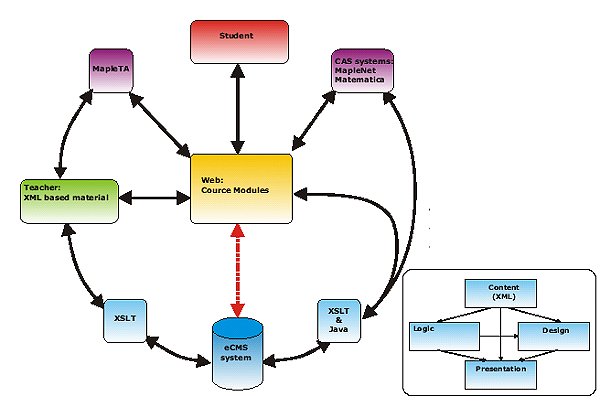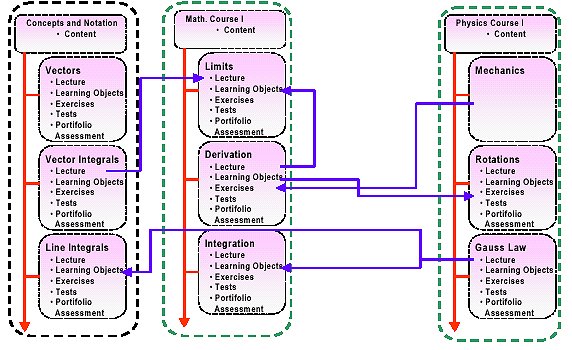 Home Home

 Objectives Objectives

 Partners & Contact Partners & Contact

 Project Proposal Project Proposal

 Reports Reports

 Publications Publications


 Dissemination Dissemination

 Project Members Project Members
|

|
Project Objectives
 |
Distance education programs of natural sciences combining asynchronous eLearning
with synchronous AV-learning, have been used with success the recent years.
Universities use new developments such as multi-point videoconferencing over IP
and shared applications, including Smartboard technology, with great success to
incorporate distance learning into their ordinary on-campus programs. However,
demand has been developing both for asynchronous and synchronous authoring,
presentation and collaboration tools that promote use of standard mathematical
and scientific notation (SMSN). In addition to overcoming geographical constraints,
such tools must overcome the increased requirements for time-effective
communication during the educational process in these fields. For this reason,
frameworks enabling administrators, educators, learners, and researchers to
interact efficiently by exchanging rich media documents that contain large
amounts of formulas, graphs and sketches, together with animations and
simulations in sophisticated combinations, have become a necessity.

NS-eCMS Architecture Overview
These trends introduce a whole new layer of challenges and possibilities for
engaging interactive communication between authors and users of content.
Demand has been developing by companies seeking to extend the skills of
their employees through continuous learning, by individuals seeking higher
education or life long training for the achievement of their career goals,
by on-campus students who use Internet as a natural information and
communication tool, and by teachers who are challenged to design engaging
material in a host of new ways and communicate the material through Internet
as an integral part of their teaching in both on-campus and distance education
programs.
Vendors of eLearning Distance Learning Platforms do not yet support SMSN
because distance learning on most subjects, which are generic, does not
require it. On the other hand, lack of SMSN and simple integration of, for
instance, sketches limits the utility of distance learning wherever there
is a strong technical component in the educational material. While several
advanced and comprehensive Computer Algebraic Systems (CAS) exist, they are
typically prohibitively expensive and several of them promote a license
policy that is too heavy for universities to administrate. The need for
deployment of such tools to large numbers of learners as well as the lack
of convenient standardization properties and high user thresholds in such
tools limits the usefulness of existing solutions in distance education
programs of natural sciences at both high school and higher education.
For this reason, institutions in Europe have been often forced to use
unsuited tools and web solutions in an effort to upgrade content that
contains technical components.
The NS-eCMS project focuses
an open web-based content management, communication and
collaboration system for the support of distance learning of natural
sciences. Management of media rich material will be achieved through the
design and implementation of an open, federated architecture enabling
straightforward design, exchange and publication through International
standard formats, specifically MathML and XML, across Europe through the Web.
An overview of the NS-eCMS system architecture is presented in the
above figure. The
architecture aims to address the full range of needs of the eLearning
process for natural sciences, from content management, to learning management,
integration with CAS servers, examination management, etc.
Information will be represented internally using XML to ensure
compatibility with standards, interoperability, and extensibility into
future applications. The architecture is based on the separation of
concerns principle, ensuring independence of the application logic
from the user interface.
The specific objectives of the system are:
Efficient educational content management, emphasizing use of standard mathematical formalism in natural sciences.
Single point of access to possibly distributed content and services, with internal information representation using inter-national standards, specifically MathML (XML), to ensure compatibility with present or forthcoming eLearning initiatives.
A straightforward user interface enabling easy introduction of elements related to the teaching of natural sciences, including mathematical formulas, graphs and sketches/drawings, into the system. Multiple interaction methods will be explored, including web technology, electronic blackboards and digital document cameras, and light pens (e.g. Wacom and/or Smart Pen Try).
Integration of mathematical software tools for the on-line execution of computations and visualization of results. Commercial web-based tools such as MapleNet and MapleTA will be explored. Furthermore, the possibility of integrating legacy code developed at the participating institutions will be explored as proof of concept.
Services for the support of cheap online web-solutions for large groups of learners based on the above-mentioned infrastructure. Services to be implemented include on-line learner assessment through examinations and exercises.
Efficient collaboration and communication that facilitates the learning process through asynchronous tools (chat-rooms, forums, collaborative space sharing) and synchronous applications as video-conferencing through desktop units.
Organized state of the art educational content for natural sciences that takes advantage of the proposed infrastructure and MathML for effective information presentation, using the calculator- or symbolic mode of the commercial tools.
NS-eCMS promotes course structuring that promotes flexibility without
sacrificing usability. The system infrastructure allows the developement of
hierarchical as well as the possibility of module reuse for the creation of
value-adding educational entities. An example of course organization is
presented below.

|
